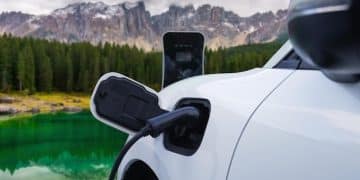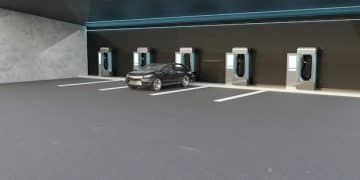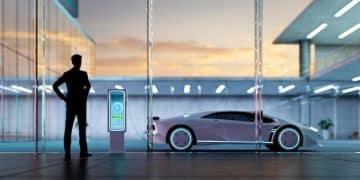Electric Vehicle Charging Breakthrough: 15-Minute Charge for Most Models
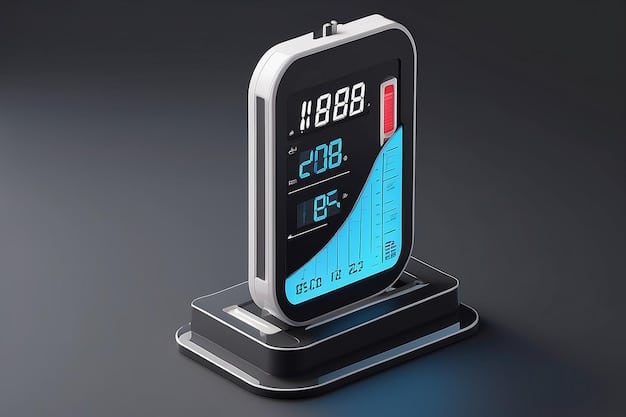
Electric Vehicle Charging Time Breakthrough: New Fast-Charging Technology Reduces Charging Time to 15 Minutes for Most Electric Vehicle Models, promising to revolutionize EV adoption by mitigating range anxiety and enhancing convenience for drivers.
The **Electric Vehicle Charging Time Breakthrough: New Fast-Charging Technology Reduces Charging Time to 15 Minutes for Most Electric Vehicle Models**,marking a paradigm shift in the EV landscape, addressing a major barrier to widespread adoption: lengthy charging times.
The Dawn of Ultra-Fast Charging for Electric Vehicles
The electric vehicle (EV) market is rapidly evolving, and one of the most significant advancements is the emergence of ultra-fast charging technology. This breakthrough promises to dramatically reduce the amount of time it takes to charge an EV, making electric vehicles more appealing to a broader range of consumers.
The Need for Speed: Why Fast Charging Matters
For years, one of the primary concerns regarding electric vehicles has been the extended charging times compared to the quick refueling process of gasoline-powered cars. Addressing this concern is critical to accelerate the adoption of EVs.
- Convenience: Shorter charging times mean drivers can quickly replenish their battery and continue their journey.
- Range Anxiety: Fast charging capabilities alleviate concerns about running out of battery on longer trips.
- Accessibility: Faster charging makes EVs more practical for those living in apartments or without access to home charging.
Ultra-fast charging aims to bridge the gap between the refueling experience of traditional vehicles and the charging process of EVs.
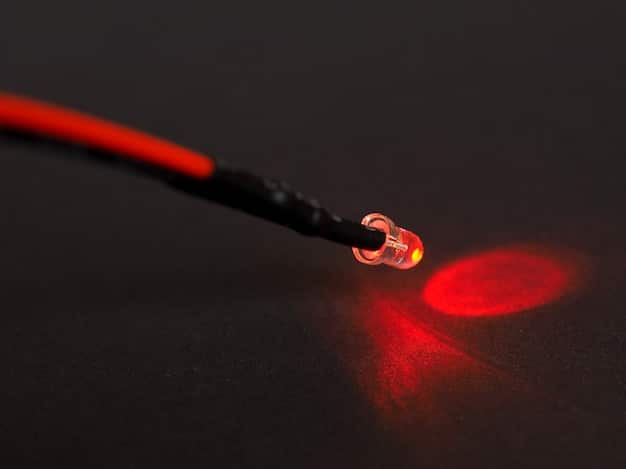
Innovations in battery technology and charging infrastructure are making it possible to deliver significantly more power to EVs in a shorter amount of time. This is poised to transform how people use and perceive electric vehicles, potentially leveling the playing field with gasoline cars.
Breaking the Barrier: 15-Minute Charging Technology
Recent advancements have resulted in the development of charging technologies capable of delivering a full charge to most EV models in approximately 15 minutes. This is a game-changer that addresses a major pain point for potential EV buyers.
How Does This Technology Work?
Several key elements contribute to this revolutionary charging speed.
- Advanced Battery Chemistry: Modern EV batteries are designed to handle higher charging rates without degrading quickly.
- Improved Thermal Management Systems: Efficient cooling systems prevent overheating during rapid charging.
- High-Power Charging Stations: New charging stations are capable of delivering significantly more power than older models.
These combined improvements allow for faster and more efficient energy transfer, resulting in considerably shorter charging times.
The introduction of 800V charging architecture is also instrumental in achieving these speeds, as it allows for higher power input without increasing the current, thus reducing heat generation and improving efficiency.
The Impact on EV Adoption and Infrastructure
The availability of 15-minute charging has a profound impact on the adoption rate of electric vehicles and the expansion of charging infrastructure.

Increased Consumer Confidence
One of the most significant impacts is the boost in consumer confidence. Knowing that an EV can be charged as quickly as filling up a gas tank eliminates a major barrier for many potential buyers.
- Reduced Range Anxiety: Drivers are less concerned about running out of power on long journeys.
- Convenience for Daily Use: Quick charging makes EVs more practical for daily commutes and errands.
- Attractiveness to New Buyers: Fast charging capabilities make EVs more appealing to a broader audience.
This improved charging experience is likely to encourage more people to make the switch from gasoline cars to electric vehicles.
The expansion of charging infrastructure is also critical to support the growing number of EVs on the road. Governments and private companies are investing in building more fast-charging stations in convenient locations such as highway rest stops, shopping centers, and urban areas.
Challenges and Considerations for Widespread Implementation
While 15-minute charging technology is an exciting development, there are still challenges and considerations to address for its widespread implementation.
Infrastructure Costs
Deploying high-power charging stations requires significant investment. The cost of upgrading the electrical grid and installing advanced charging equipment can be substantial.
These costs can be a barrier to rapid expansion, particularly in rural or less affluent areas. Government incentives and private investment are crucial to overcome this challenge.
Battery Health and Longevity
Repeatedly charging batteries at high rates can potentially impact their long-term health and lifespan.
Manufacturers are working on developing battery management systems that can mitigate these effects. These systems monitor battery temperature, voltage, and other parameters to optimize charging and prevent damage.
Consumers also need to be educated about best practices for maintaining their EV batteries, such as avoiding frequent deep discharges and extreme temperatures.
Continued research and development are essential to ensure that fast charging does not significantly degrade battery performance over time.
The Role of Government and Industry Collaboration
Government regulations and industry partnerships play a critical role in promoting the adoption of fast-charging technology and ensuring its safe and reliable implementation.
Setting Standards and Regulations
Governments can establish standards for charging equipment and protocols to ensure interoperability and safety.
- Charging Standards: Standardizing charging connectors and communication protocols promotes compatibility across different EV models and charging stations.
- Safety Regulations: Ensuring that charging equipment meets stringent safety standards protects consumers from potential hazards.
- Grid Stability: Implementing regulations to manage the impact of EV charging on the electrical grid helps prevent overloads and disruptions.
These standards and regulations provide a framework for the industry to innovate and deploy fast-charging technology in a responsible manner.
Collaboration between automakers, charging network operators, and utility companies is essential to address the challenges of infrastructure deployment and grid integration. By working together, these stakeholders can accelerate the transition to electric mobility and ensure that EVs are a sustainable and convenient transportation option for everyone.
Future Trends in Electric Vehicle Charging
The future of electric vehicle charging is likely to be shaped by several emerging trends and technological advancements.
Wireless Charging
Wireless charging technology allows EVs to be charged without the need for cables or plugs. This can be particularly convenient for home charging or public parking.
While wireless charging is still in its early stages of development, it has the potential to become a mainstream charging method in the future.
Battery Swapping
Battery swapping involves replacing a depleted battery with a fully charged one at a swapping station. This approach can provide an even faster “refueling” experience than fast charging.
Battery swapping is gaining traction in some markets, particularly for commercial vehicles and ride-hailing services.
Vehicle-to-Grid (V2G) Technology
V2G technology enables EVs to not only draw power from the grid but also to send power back to the grid when needed. This can help stabilize the grid and provide additional revenue streams for EV owners.
V2G technology is still in its early stages, but it has the potential to transform EVs from passive consumers of electricity into active participants in the energy market.
| Key Point | Brief Description |
|---|---|
| ⚡ 15-Minute Charging | New tech drastically cuts EV charging times. |
| 🚗 Increased Adoption | Faster charging solves ‘range anxiety,’ attracting more buyers. |
| 💰 Infrastructure Investment | Massive upgrades needed for widespread fast charging. |
| 🔋 Battery Longevity | Managing battery health during rapid charging is crucial. |
Frequently Asked Questions
▼
The new technology combines advanced battery chemistry, improved thermal management, and high-power charging stations to deliver significantly more power to EVs in a shorter time.
▼
It significantly boosts consumer confidence by reducing range anxiety and making EVs more convenient for daily use, attracting a broader audience to consider electric vehicles.
▼
The primary challenges include high infrastructure costs for upgrading the electrical grid and installing advanced charging equipment, as well as concerns about the long-term impact on battery health.
▼
Governments can establish standards for charging equipment, ensure safety regulations, and provide incentives for infrastructure development, fostering a supportive environment for fast-charging deployment.
▼
Future trends include wireless charging, battery swapping, and vehicle-to-grid (V2G) technology, promising greater convenience and grid stability as the EV market continues to evolve.
Conclusion
The development of fast-charging technology represents a significant leap forward for the electric vehicle industry. By reducing charging times to just 15 minutes, this innovation addresses a major barrier to EV adoption and makes electric vehicles a more practical and appealing option for consumers. As infrastructure continues to expand and technology evolves, electric vehicles are poised to play an increasingly important role in the future of transportation.

